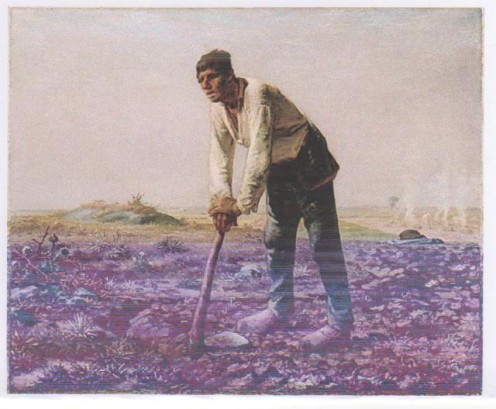Revisiting a poem which taught me how to love
The Man with the Hoe
It was in a literature class in high school that I first felt so attracted to a poem that was not among the type of love poems my peers loved to memorize. Like the rest of my classmates, I memorized poems I liked and recited them with passion. “How do I love thee, let me count the ways” by Elizabeth Barrett Browning was a favorite of my friends. We would recite this poem together any time we had the chance to be under a big tree before the bell rang. Rolando Carbonell’s “Beyond Forgetting” was also a favorite. But when I memorized “The Man with the Hoe” and felt so proud reciting it, my friends said it was too long. But “Beyond Forgetting” was just as long, I said. There was something in Edwin Markham’s “The Man with the Hoe” that just took me by the hand. I had no developed social conscience then but I had a feeling that “The Man with the Hoe” was my poem. I just loved to recite it.
In 1987, in an evening activity commemorating EDSA I in the Philippines, I read “The Man with the Hoe” with all the feelings that I could put into it. After reading the poem which I could have recited by heart, something dawned on me: “This poem will be among my life’s treasures just like the song “Impossible Dream”.
When there were instances during mass actions where I would have the chance to recite “Lumuha ka Aking Bayan” by Amado Hernandez, a great Filipino poet, in my heart I was also reciting “The Man with the Hoe.” This poem was written by Edwin Markham and was first presented in a poetry reading in 1898. Yes, friends………..a century and a decade ago and up to this day, it’s spirit is the same spirit that permeates the struggles of poor nations. The poem is written in a traditional style but when you listen to it, it’s voice is ageless in the same manner that social conscience is ageless. In the course of my musings about Edwin Markham’s famous poem, I had the irresistible urge to get to know what was in the poet’s mind when he wrote the poem. Luckily, I found the poet’s reflection on writing the poem. (http://www.english.illinois.edu/maps/poets/m_r/markham/reflections.htm)
Here’s “The Man with the Hoe” and a picture of the painting that inspired Edwin Markham to let out that energy in his soul that would spread to Labor Unions and many different groups that untiringly look for solutions to the systemic issues that reduce people to figures similar to the man in the painting of Jean-François Millet (http://en.wikipedia.org/wiki/Jean-Fran%C3%A7ois_Millet)
Now, in my late adult years, I have learned to sort out the different dimensions of loving. I’m way past the narrow definition of loving as the years have taught me what the human landscape is all about. Embracing the struggle of the human spirit is love in its purest form. Here’s the poem that always made me return to the meaning of true love.
The Man with the Hoe
Bowed by the weight of centuries he leans
Upon his hoe and gazes on the ground,
The emptiness of ages in his face,
And on his back the burden of the world.
Who made him dead to rapture and despair,
A thing that grieves not and that never hopes.
Stolid and stunned, a brother to the ox?
Who loosened and let down this brutal jaw?
Whose was the hand that slanted back this brow?
Whose breath blew out the light within this brain?
Is this the Thing the Lord God made and gave
To have dominion over sea and land;
To trace the stars and search the heavens for power;
To feel the passion of Eternity?
Is this the Dream He dreamed who shaped the suns
And marked their ways upon the ancient deep?
Down all the caverns of Hell to its last gulf
There is no shape more terrible than this —
More tongued with censure of the world's blind greed —
More filled with signs and portents for the soul —
More fraught with menace to the universe.
What gulfs between him and the seraphim!
Slave of the wheel of labor, what to him
Are Plato and the swing of Pleiades?
What the long reaches of the peaks of song,
The rift of dawn, the reddening of the rose?
Through this dread shape the suffering ages look;
Time's tragedy is in the aching stoop;
Through this dread shape humanity betrayed,
Plundered, profaned, and disinherited,
Cries protest to the Judges of the world.
A protest that is also a prophecy.
O masters, lords and rulers in all lands,
Is this the handiwork you give to God,
This monstrous thing distorted and soul-quenched?
How will you ever straighten up this shape;
Touch it again with immortality;
Give back the upward looking and the light;
Rebuild in it the music and the dream,
Make right the immemorial infamies,
Perfidious wrongs, immedicable woes?
O masters, lords and rulers in all lands
How will the Future reckon with this Man?
How answer his brute question in that hour
When whirlwinds of rebellion shake all shores?
How will it be with kingdoms and with kings
With those who shaped him to the thing he is
When this dumb Terror shall rise to judge the world.
After the silence of the centuries?
The Painting that inspired Edwin Markham to write "The Man with the Hoe"






